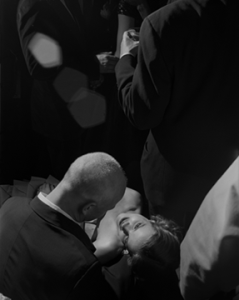Over the course of ten years, Larry Fink, whose photographs are now on view in LACMA’s exhibition, shot Vanity Fair’s legendary annual Oscar party. He was brought in as an alternative view, with no propensity towards chasing celebrity—unusual, considering that since its inception in 1994 at Morton’s in Beverly Hills, the party had become a Who’s Who of Hollywood elite.

Larry Fink, Natalia Vodianova, 2007.
In fact, Fink swears he had no idea who most of the celebrities were until he began to see the same faces year after year. Instead, he sought that odd moment of physicality—an illuminated arm hovering in mid air behind a quizzically craned neck and a glance (who happens to be Lindsay Lohan), or the unspoken but clear words articulated from a clenched fist or an open palm. LACMA’s exhibition, Larry Fink: Hollywood, 2000–2009 displays thirty-seven pictures with this particular knack for tracing the sensuality of things back to their source.

Larry Fink, Harry Dean Stanton, Dennis Hopper, and Kid Rock, 2007.
In a conversation I had with Fink, who is a lover of the blues, he compared his ideology on photography to music. “When a musician goes off for a high note and they look for that ecstasy or deliverance, it’s always that moment where there’s a higher truth being looked for or asked for. It’s that moment where they actually meet the maker, and even though the maker is not going to gift them with anything more than what that moment can give, at least, and at most, there is some kind of merger of the spirit, the ambition, and the toil of life all put into one little arena. It’s redemptive transformation. And everything on the way.” Fink has a high-pitched laugh that shows itself every once in awhile, and he finalized this statement with near-hysterical interjection. It made me giddy and I wanted to ask more questions about the complexities of music making, of bowling three perfect games when he was a teen (he did—in one year), of the good and evil of boxing (which he photographed for his 1997 monograph, Boxing), all topics he seemed to enjoy talking about as we strayed from the literal subject of photography.
I shared some of my own stories with him. While many of the photographs exhibited in Larry Fink were being taken, I was across town, a few floors up from the Kodak Theatre (where the Oscars are held) making memories at the “official” Academy-sanctioned post-Oscars party known as the Governors Ball. Some of these memories were personal (a dark nimbus of pain in my feet, glorious mountains of shellfish), others professional (“Javier Bardem with John Stewart, section Y, table 47!” exclaimed into a walkie-talkie). Though I attended this ball five years in a row, I was not an invited guest. I served as the Academy’s in-house photography coordinator, assisting four dedicated photographers to find electrical moments—when one shining star came into contact with another shining star—worthy of the Academy’s historic photograph archive.
I wished I had a team of Larry Finks. I wished I could have encouraged the Academy photographers to roam free to shoot as they wished, driven by intuition, deaf to my suggestions, oblivious to the brute iconography of celebrity. In the grip of capturing the image of stardom rather than humanity, it rarely happened. In his graceful depiction of unconscious gesture and expression, Fink has made his photographs different from anything that was ever orchestrated via press office walkie-talkie. Yet, despite this delineation, Larry Fink provokes the issue of making art versus depicting celebrity. With the Fink exhibit, to dispassionately view Oscar-party photographs in an art museum may raise an eyebrow or two. Do Fink’s images have a place here? Does all such imaging of celebrity eclipse art?
My conclusion is that if you are open to complexities of human engagement within the museum context, Fink’s photography will draw you in. While engaging with these images, you can decide if they are art or not. The selection of photographs include the likes of Russell Simmons, Faye Dunaway, Arianna Huffington, and Spike Lee, among many more, as they hug each other, love each other, and perhaps love themselves. Walking through Larry Fink: Hollywood, 2000–2009 is like making your way to the bar at a crowded event. You cast glances as you go, recognizing faces with which you have no real personal connection. In one picture Harry Dean Stanton and Dennis Hopper are gently illuminated and formally separated from the rest of the party, seated on a stuffed couch from which they silently observe the strange universe rotating around them. And just when you think you can remain the voyeur, Tom Ford stares out of a frame at you, asking why you are there. Fink, while unintentionally fulfilling the special promise of Hollywood—that you are always welcome to dream about celebrity—freezes the best of these glances in time. These photographs are memories we don’t have, of celebrities we don’t know, and within this engagement are the formal qualities of gesture cut by light and dark, which elevate these images from the pages of a glossy magazine, transcending the Who’s Who. At the end of my visit to the exhibition, I didn’t much care to leave the party.
Sarah Bay Williams is a graduate student of art history at the University of California, Riverside. She was previously a fellow in LACMA’s photography department.



